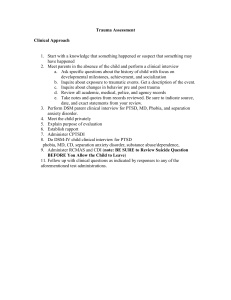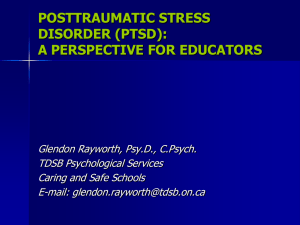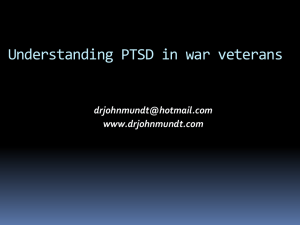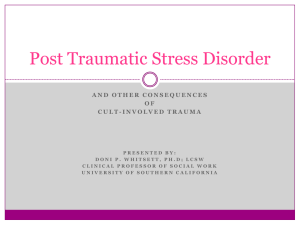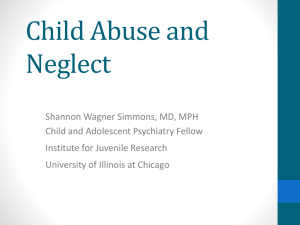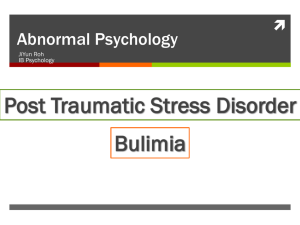PTSD Pri Med Lecture - Institute for Health & Healing News
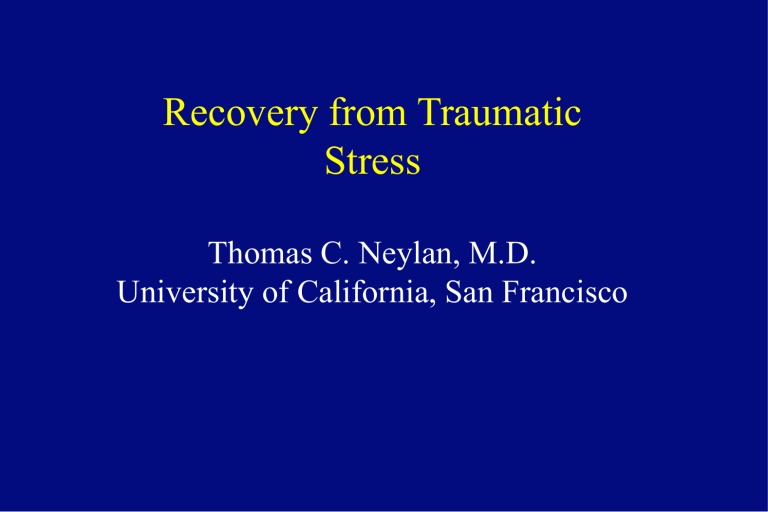
Recovery from Traumatic
Stress
Thomas C. Neylan, M.D.
University of California, San Francisco
History of Posttraumatic Stress Disorder
Homer: Trojan War Veterans
Civil War: Soldier’s Heart
19th Century Europe: Railroad Spine
WW I: Shell Shock
Vietnam War: Vietnam Syndrome
1976 Horowitz: Stress Response Syndromes
1980 DSM III: PTSD
Case Study
29-year-old single women
Combat helicopter pilot from Iraq War
Shot down, and R shoulder rotator tear, and upper arm laceration
Recovered quickly from injury, but insisted on early retirement
Seeks help for poor sleep and irritability
Case Study
(cont.)
What additional information would you want to obtain to evaluate her?
PTSD DSM-IV Criteria
Exposure to traumatic event with
Actual or threatened death or serious injury and
Response involving intense fear, helplessness, or horror
American Psychiatric Association. DSM-IV.
1994.
PTSD DSM-IV Criteria (cont.)
Re-experiencing the traumatic event
Persistent avoidance of stimuli associated with event
Numbing of general responsiveness
Symptoms of increased arousal
At least 1 month’s duration (otherwise can diagnose Acute
Stress Disorder)
Significant distress or impairment in social, occupational, or other functioning
American Psychiatric Association. DSM-IV.
1994.
7
PTSD
Associated Features
Alcohol/drug problems
Aggression/violence
Suicidal ideation, intent, attempts
Dissociation
Distancing
Problems at work
Marital problems
Homelessness
Epidemiology of PTSD
National Comorbidity Study
7.8% of adults in the U.S. (lifetime)
Type of trauma most often the basis for PTSD:
– rape in women (46% risk)
– combat in men (39% risk)
1/3 of cases have duration of many years
88% of cases have psychiatric comorbidity
Kessler RC, et al. Arch Gen Psychiatry. 1995;52:1048-60.
Combat-Related PTSD: Epidemiology
Lifetime Prevalence:
30% in Vietnam veterans
5-10% of Gulf War I deployed veterans
10-20% in Operation Enduring Freedom and
Operation Iraqi Freedom
VIETNAM: Kulka RA, et al. Trauma and the Vietnam war generation: Report of the findings from the National Vietnam Veterans
Readjustment Study. 1990, New York: Brunner/Mazel.
GULF WAR: Stretch RH et al. Military Medicine. 1996;161:407-410.
IRAQ WAR: Hoge, C.W., et al. R.L. N Engl J Med. 2004;351:13-22.
Primary Psychiatric Disorder 6 Months
Following Trauma
Responses to Trauma Are Heterogeneous
40
30
20
10
0
80
70
60
50
McFarlane, et al. Ann N Y Acad Sci. 1997;821:437-441
Longitudinal Course of PTSD Symptoms
94%
47%
42%
?
W 3m 9m
Kessler RC, et al. Arch Gen Psychiatry. 1995;52:1048-60.
30%
Years
Twelve-Month Prevalence of DSM-IV
Major Psychiatric Disorders
%
Mood Disorders
Major depressive episode
Dysthymia
Manic episode
Anxiety Disorders
Social Phobia
Simple Phobia
PTSD
Agoraphobia without panic
GAD
Panic disorder
Substance Use Disorders
Alcohol abuse/dependence
Drug abuse/dependence
6.7
1.5
2.6
4.4
1.8
6.8
8.7
3.5
0.8
3.1
2.7
Adapted from Kessler RC, et al. Arch Gen Psychiatry. 2005;62:617-627.
Prevalence of Trauma and Probability of PTSD
40
%
30
20
Prevalence of Trauma
1
10
0
Witness Accident Threat w/
Weapon
Physical
Attack
Molestation
Probability of PTSD
2
%
70
60
50
40
30
20
10
0
Witness Accident Threat w/
Weapon
1. Kessler R et al. J Clin Psychiatry. 2000;61(Suppl 5):4-14.
2. Kessler R et al. Arch Gen Psychiatry. 1995;52:1048-1060.
Physical
Attack
Combat
Molestation Combat
Male
Female
Rape
Rape
Risk Factors for PTSD
Severity of trauma (ie, threat, duration, injury, loss)
Prior traumatization
Gender
Ethnicity
Prior mood and/or anxiety disorders
Family history of mood or anxiety disorders
Education
Screening Questions for PTSD
“What’s the worst thing that ever happened to you?”
“How did you react when it happened?”
“Do memories of _______ still bother you? Did you get over it?”
“Do you avoid situations that might remind you of ____?
Have your relationships suffered because of ____?”
“Have you become more nervous since ___? Is it hard for you to relax because of ____?”
Functional Neuroanatomy of Traumatic Stress
Stress
Parietal Cortex
Prefrontal
Cortex
Orbitofrontal
Cortex
Extinction to fear through amygdala inhibition
Hypothalamus
Amygdala
Conditioned fear
Hippocampus
Glutamate
CRF
Pituitary
ACTH
NE
Cerebral Cortex
Long-term storage of traumatic memories
Attention and vigilance - fear behavior
Dose response effect on metabolism
Locus Coeruleus
Output to cardiovascular system Adrenal
Cortisol
PTSD Treatment Options
Psychotherapy
Pharmacotherapy
Complementary Alternative Interventions
– Yoga
– Exercise
– Meditation
Multimodal treatment
Early Post-Trauma Interventions
Crisis Interventions —Short cognitive behavioral therapy (CBT):
Psychological Debriefing —equivocal or harmful
Cognitive Behavioral Prevention Programs:
Prolonged Exposure (PE)
Prolonged Exposure + Stress Inoculation Training (PE/SIT)
Psychotherapy
Brief dynamic psychotherapy for traumatic grief
Supportive counseling
Spiritual counseling
Pharmacotherapy
Propranolol
Foa EB, et al. J Clin Psychiatry. 1999;60(suppl 16):1-34.
Mitchell JT. JEMS. 1983;8:36-9.
Psychological Treatments for Chronic PTSD
Psychotherapy
Exposure therapy
Cognitive processing therapy
Anxiety management
Additional treatments
Eye Movement Desensitization and
Reprocessing (EMDR)
Hypnotherapy
Psychodynamic therapy
Expressive therapies
Meta-analysis of Pharmacotherapy for PTSD
35 RCTS with 17 positive placebo-controlled trials
Medication response in 59.1%
Placebo response in 38.5%
SSRIs most effective
Medication effects greater for co-morbid depression and disability
3 maintenance trials suggest long-term medication
Adrenergic-Inhibiting Agents:
Alpha
1
-Adrenergic Blockers
Prazosin* 7 to 15 mg qhs
Alpha
1
- post-synaptic adrenoceptor receptor antagonist
Alpha
1 receptors widely distributed in the brain, including the amygdala and hippocampus
Alpha
1 receptors modulate sleep and startle responses
Double-blind RCT in 40 veterans, 13.3 +/- 3 mg 1
– Robust improvement in sleep quality and distressing dreams
–
Medium to large effect size in each PTSD Sx cluster
– Adverse reactions include: syncope, dizziness, drowsiness, decreased energy, headache
*Not FDA approved for the treatment of PTSD
1. Raskind, et al. Biol Psychiatry. 2007; 61: 928-34.
Effects of a yoga breath intervention alone and in combination with an exposure therapy for post-traumatic stress disorder and depression in survivors of the 2004
South-East Asia tsunami.
Descilo T , Vedamurtachar A , Gerbarg PL , Nagaraja D ,
Gangadhar BN , Damodaran B , Adelson B , Braslow LH ,
Marcus S , Brown RP .
The Trauma Resolution Center of Miami, Miami, FL, USA
Acta Psychiatr Scand. 2009 Aug 19. [Epub ahead of print]
JOURNAL OF CLINICAL PSYCHOLOGY, Vol. 66(1),
17--33 (2010)
Exercise and Neurogenesis?
Growth factor signaling genes
Growth factor signaling genes upregulated by exercise
VGF involved in energy balance
& synaptic activity; increased by ECS
Sedentary Exercise
Exercise increases VGF mRNA in the hippocampus
Slide adapted from D. Shin
Summary: Recommendations for
Immediate Management
Move to safety and reduce terrifying arousal
Psychological First Aid
– Low arousal, facilitate cognitive processing
Education and support
Emphasize need to sustain interpersonal connections
Screening for risk factors and follow up
